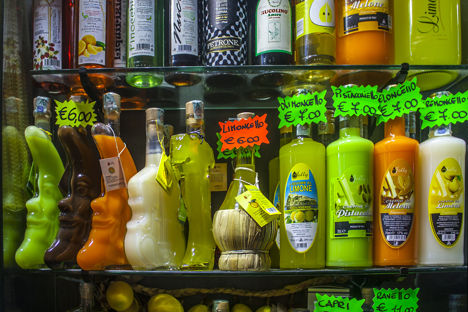
Abruzzo’s local amari and liqueurs
Often strong, always bitter and full of herbal, citrusy flavour, the various liqueurs (or liquori), infusions and distillates of Abruzzo are perfect after-dinner digestifs and have become the secret weapon of many world-class bartenders. Here are some of the most popular.
Abruzzo’s local amari and liqueurs
Often strong, always bitter and full of herbal, citrusy flavour, the various liqueurs (or liquori), infusions and distillates of Abruzzo are perfect after-dinner digestifs and have become the secret weapon of many world-class bartenders. Here are some of the most popular.
Many of us have enjoyed or made our own infused alcohols before. Flavoured vodkas and gins simply require a bottle of the chosen spirit and a handful of fruits, herbs or spices submerged within it. Several months later voila – you have something delicious to sip on. But in Italy, and particularly the central region of Abruzzo, the centuries-old tradition of creating liqueurs, digestifs and amari (as they are generally known in Italy) has resulted in some seriously complex tipples. Many were originally created for medicinal purposes, as they tend to contain a whole host of herbs and flowers, but today they’re usually sipped after a meal to aid digestion, drunk neat over ice as an aperitivo or become part of modern, innovative cocktails.
Abruzzo is responsible for creating some of Italy’s most historic and complex amari. While flavoured liqueurs are produced all over the country – those that have enjoyed global recognition include limoncello, Frangelico from Piedmont, Fernet-Branca from Milan and Aperol from Veneto – Abruzzo is where you’ll find the widest range of varieties, often produced by artisans in small batches. They’re often used to flavour the local festive pastries, bocconotti, and work well when marinating meat, but to get a real idea of how they taste they should be sipped neat.
Many amari are quite simple, combining high-strength neutral alcohol with just one infused ingredient (popular choices include saffron, juniper berries, bay leaves, basil and liquorice), but the ones listed below are much more complex. If you’re in Abruzzo then look in pastry shops for bottles to buy, but many specialist spirit merchants will stock Abruzzese amari as well.
Genziana
Gentian liqueur is something produced in various parts of western Europe, but the Genzianaof Abruzzo is regarded as one of the finest examples. Made from the roots of the yellow gentian flower, which can be found growing high up in the Abruzzi Apennine Mountains, the liqueur is yellow and incredibly bitter, which is why sugar is often added. It was often drunk in the 1950s as it was believed gentian root could stave off Malaria, but now it is served after big meals to aid digestion. Many families include other ingredients such as coffee beans, bay leaves, cinnamon and white wine in the infusion alongside the bitter root.
Centerbe
One of Abruzzo’s most iconic liqueurs, this bright green spirit is often very strong (around 70% ABV) and based on an ancient Benedictine monk recipe. It came to prominence in the nineteenth century when it was developed into a product by a chemist who thought it could combat cholera, a disease rife in the region during 1884. Centerbe is made with around 100 different wild herbs which are foraged for in the Abruzzi mountains, giving it a very unique taste, and it tastes grassy and very bitter. Recipes can vary from family to family, often fiercely guarded and passed down through the generations.
Aurum
A sweeter, more approachable drink than some of Abruzzo’s more bitter amari, Aurum is a brandy-based liqueur flavoured with oranges at around 40% ABV. Named after the Latin word for gold, Aurum has roots in Ancient Rome, but it wasn’t properly produced and marketed until the Pomillio family started making it in the 1920s. Many Abruzzese cakes and pastries are flavoured with Aurum thanks to its citrusy taste.
Punch Abruzzo
In 1907, Antonio Evangelista (the mayor of Borrello, Chieti) decided to start selling the homemade liquore he gave friends and family in the winter to the wider public. Punch Abruzzo was born, and today the Evangelista company continues to produce it to the secret family recipe, which has been handed down through several generations. At 45% ABV it is quite strong, which is why it is usually mixed with warm water or milk and enjoyed as a digestif. With flavours of citrus, coffee, rum and spices, it’s also very nice poured over ice cream or used in desserts.
Ratafià
Ratafià is the name for a variety of different drinks found in everywhere from France to Catalonia, but Abruzzese Ratafià is unique in that it combines fresh dark Amarena cherries, sugar, vanilla, cinnamon and pure alcohol with local Montepulciano d’Abruzzo red wine. Legend has it that a form of this liqueur was drunk in Ancient Rome to ratify legal documents (hence the name), but today it tends to be served alongside ice creams, pastries and other desserts.
Nocino
A liqueur flavoured with green walnuts, Nocinois found throughout Italy but some of the best examples come from Abruzzo. Traditionally the unripe walnuts would be picked on 24 June (the saint day of St John the Baptist) as walnut trees were associated with witches and people believed he would protect them. Family recipes for Nocino are closely guarded secrets, and many of them also contain coffee beans, vanilla, lemon peel, cloves or allspice.

